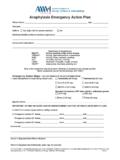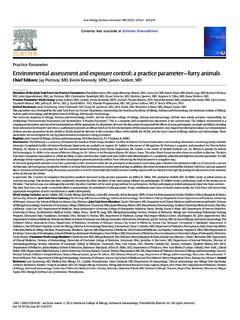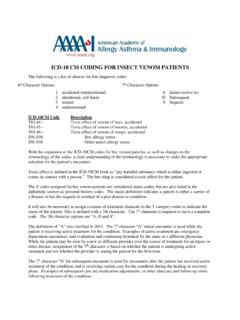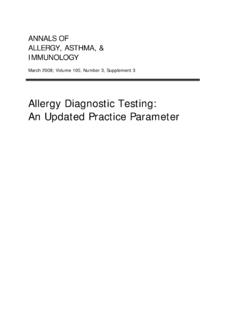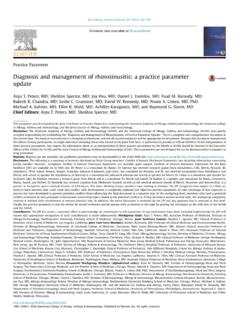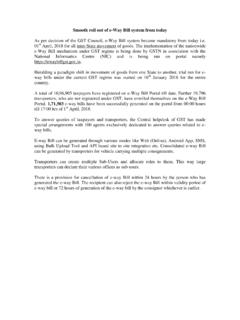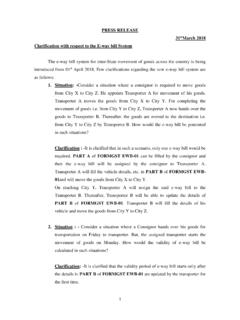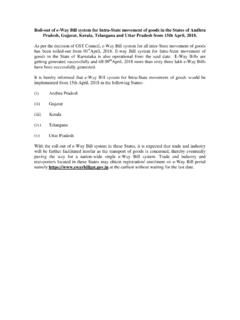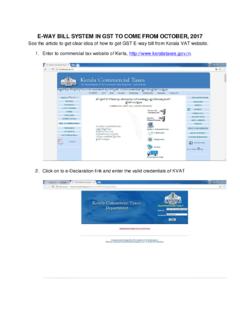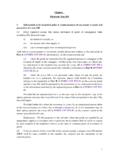Transcription of CHAPTER 6
1 AAAAI Practice Management Resource Guide, 2014 edition 1 CHAPTER 6 Coding and Billing BasicsTeresa Thompson, BS, CPC, CMSCS, CCCTABLE OF CONTENTS1. Overview of Physician Coding and Billing2. Documentation3. Diagnosis Coding4. Procedure Coding5. Evaluation and Management Codes6. Levels of Service Selection for Evaluation and Management Codes7. ReferencesOVERVIEW OF PHYSICIAN CODING AND BILLINGWith the increase in oversight and the continuous pressure to provide healthcare services in the most cost-efficient method, it s necessary to thoroughly understand the current reimbursement system to maintain an active and financially healthy practice.
2 Physician services are routinely submitted to third-party payers in alpha- numerical as well as numerical codes for appropriate alpha numerical and numerical coding system is a translation of the information documented in the medical record. The purpose of this translation is appropriate compensation for the healthcare provider as well as data collection for analysis by the healthcare systems for all patients and their diseases. With HIPAA, documentation of the patient encounters is mandatory to justify the codes submitted to third-party payers for reimbursement. This applies not only to Medicare but to all other insurance carriers throughout the country. Therefore, documentation of the encounter with the patient is now not only important for good patient care, but also for third-party reimbursement and utilization of healthcare Principles of DocumentationThe Golden Rules for documentation are, If it is not documented, it did not happen and it is not billable.
3 If it is illegible, it is not billable. With those guidelines in mind, the general principles of documentation for patient care are as follows: Chief complaint Relevant history Physical exam findings Diagnostic tests and their medical necessity Assessment/impression and/or diagnosis Plan/recommendation for care Length of visit, if counseling and/or coordination are provided Date of service and the verifiable, legible identity of providerThird-party insurers are reviewing documentation to justify payment of services, data and utilization. This does not mean that every encounter will be reviewed prior to payment. However, third-party insurance companies have the right to review chart notes prior to payment if they choose. From a clinical aspect, the physician or other healthcare provider is looking at documentation for appropriate information to AAAAI Practice Management Resource Guide, 2014 edition 2 CHAPTER 6 Coding and Billing Basicscontinue care of the patient, as well as support for physician is responsible for selecting the diagnosis and the procedure codes based on the documentation created for the encounter.
4 The diagnosis is the medical necessity for the procedure(s) or service(s) performed and needs to be as specific as possible. A fee is set for each current procedural terminology (CPT) code independent of what the carriers are reimbursing. The fee may be based on a percentage of Medicare, or it may be based on the cost of doing business for the practice. Many practices have an encounter form, superbill or route slip to communicate between the physician and the billing/coding staff about the nature of the services provided to the patient and the medical justification (diagnosis codes) for the encounter. The Centers for Medicare and Medicaid Services (CMS) publish a physician fee schedule each year that has relative value units (RVUs) assigned to each code.
5 The RVU is determined by the work, malpractice and overhead expense for each code. The physician fee schedule also includes a conversion factor, which is a dollar amount determined by the Congress and the CMS. This conversion factor then is multiplied by the RVU for each code to determine the financial value of each code according to Congress and the CMS. A practice may want to use a percentage of this conversion factor and the RVUs for each code as published in the Federal Register to determine the fee schedule for the coding systems currently in use for physician services are the Healthcare Common Procedure Coding system (HCPCS), which was created by the American Medical Association (AMA), and the International Classification of Diseases (ICD), which was created by the World Health Organization (WHO) and modified by the Health and Human Services Department.
6 The HCPCS system is used for services, procedures, drugs and supplies. The ICD-9-CM (International Classification of Diseases, 9th edition, Clinical Modification) codes are the diagnosis codes used to provide medical necessity for services and procedures. On October 1, 2015, a new system for diagnosis coding will be implemented: ICD-10-CM. This system will expand the number of codes available from 14,000 to >60,000. The codes will be alphanumeric and require more detailed specificity to code each patient encounter CODINGThe ICD-9-CM codes have been available for use since 1977. However, only since 1989 have the ICD-9-CM codes been required for physician professional services. In the spring of each year, diagnosis codes are reviewed and new codes are created.
7 At the same time, other diagnosis codes are revised to reflect the diseases and conditions physicians are treating. The new, revised and deleted code changes are published in the spring and are implemented for coding on Oct. 1 of each year. ICD-9 and ICD-10 coding guidelines are similar. The system has been changed to allow more diagnosis codes for specific diseases, to give more options for tracking morbidity and mortality for the Center of Disease Control and to have continuity with the World Health Organization. There is more flexibility with ICD-10 since there are more codes to choose as the appropriate diagnosis. Since the coding guidelines are similar for ICD-9 CM, emphasis will be placed on learning the new AAAAI Practice Management Resource Guide, 2014 edition 3 CHAPTER 6 Coding and Billing BasicsICD-10CM codes, which will become the standard coding system for use in physician practices.
8 ICD-10-CM coding system is arranged in the same format as the ICD-9CM book with the book divided into two sections: the index an alphabetical list of terms and their corresponding code and the tabular section a sequential alphanumeric list of codes divided into chapters based on body system or condition. The Alphabetical Index is arranged with an index to Disease and Injuries, The Neoplasm Table, Table of Drugs and Chemicals and the Index to External Causes and injuries. The Tabular list contains categories and subcategories of codes. The format for the codes is alphanumerical, with each code beginning with an alpha character and then having a mix of alpha and numerical characters for each code.
9 A valid code may range from three to seven characters. These diagnosis codes are divided into chapters, sections, subsections and subcategories. The list below gives you a look at the code breakdown: First character of a three character category is a letter Second and third characters may be numbers or alpha characters Fourth and fifth characters define subcategories and also may be either alpha or numerical characters Sixth and seventh characters also may be either numerical or alphabetical. These characters are further divisions of the subcategories described in the first through fifth position of the ICD-10CM to the ICD-10CM coding system is the use of the letter X as a placeholder when the diagnostic code needs to be expanded but there isn t a number or letter appropriate to use to complete the code expansion for a specific place.
10 For example, an initial encounter for a scorpion sting would be coded as The x is required to enable the expansion of the code to the seventh place to complete the code. The Alphabetical Index section of the ICD-10CM books is arranged in the same manner as the ICD-9 CM book, with the exception that it lacks a hypertension table. The alphabetical section also has a guide to indicate with a when the code will need an additional digit to make for a complete code. The alphabetical section is considered the index for the numerical section of the book and should be used as a person would use any other index, as a beginning point to determine where to find the correct code.
